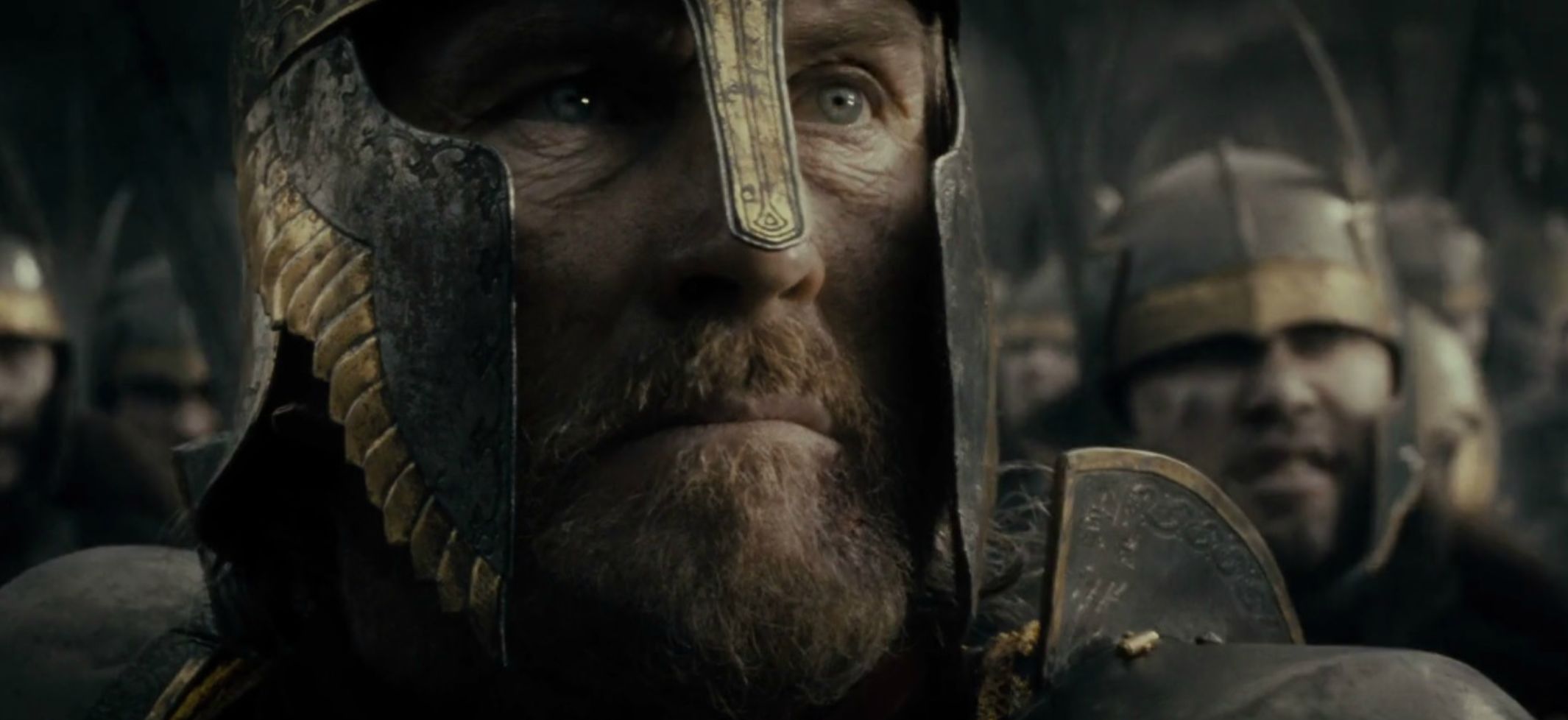Create a free profile to get unlimited access to exclusive videos, sweepstakes, and more!
Amazon's Lord of the Rings series is going to the Second Age — here's what we might expect

We finally know some pivotal details about Amazon's giant project based on The Lord of the Rings, or more accurately, the works of J.R.R. Tolkien. Possibly the biggest question surrounding this gargantuan series has been when in the history of Middle-earth it would be set — I myself was hoping for a First Age setting, but that won't be the case. That said, we're getting the next best thing. Get ready to go to the Second Age!
There will be no Fall of Gondolin, or elven genocide (unless they do flashbacks, which is possible), but! The Second Age holds a vast amount of riches, with plenty of arable land suitable for growing some incredible streaming television. What epic tales can we expect?
The Second Age of Middle-earth spans the time from Morgoth's final defeat up through the Battle of the Last Alliance, seen in the prologue of The Lord of the Rings: The Fellowship of the Ring, the first of the Tolkien films from Peter Jackson. Many interesting events take place in these 3400+ years, including (but not limited to) the Noldorin elves securing a kingdom under Gil-galad (who is briefly seen in that prologue), the founding of the Grey Havens, Elrond settling Rivendell, and the dwarves coming together (mostly) in the kingdom of Moria.
Galadriel and Celeborn also officially relocate their home to Lothlorien in this period, and it should be noted that if either they or Elrond are featured, it is devoutly wished that they continue to be played by Cate Blanchett, Marton Csokas, and Hugo Weaving. It would be odd to see anyone else in those roles.
This period also features the rise of Sauron, lieutenant of Morgoth, and hereafter the major Big Bad of Middle-earth. He becomes a major player in the Second Age, screwing around with men, elves, and pretty much everyone else. It is in this time that he secures his own kingdom in Mordor and builds his tower of Barad-dûr for the first time. Another huge occurrence in this period features Sauron making friends with an elf named Celebrimbor, the one who created the Rings of Power.
The three, the seven, and the nine were given out during this time, and as we know, Sauron took what he learned from Celebrimbor and secretly created the One Ring to Rule Them All in the fires of Mount Doom. Nine mortal men doomed to die greedily took the nine rings offered, and their corruption (and transformation into the Ringwraiths) happened soon after.
Sauron often used a different form which he used to cuckold people and bring discord — this was well before he was only able to manifest himself as a giant flaming eye. He had a body, and he could change its appearance. He would sometimes take the beautiful (yet evil) shape of Annatar, who charmed the studded pants off of everyone who met him. Who knows if we'll actually see the duping of Celebrimbor and the creation of the rings in this series … technically these events are in the Second Age, but they come awfully close (overlapping, actually) to what we see in Jackson's films. Celebrimbor, incidentally, is a major character in the Shadow of Mordor video games, though they do some weird things with him that the Professor would probably not have approved of.
The biggest piece of Middle-earth lore that we can expect to see is the one that I haven't mentioned yet. If we're going to the Second Age, then that means we're in for all kinds of drama that surrounded one location in particular, one that is clearly highlighted on Amazon's set of teasing maps. I wouldn't be surprised if the series focused everything on the insane rise and fall of this place. "Welcome to the Second Age" might as well mean "Welcome to Númenor."
Which then begs the question: What in the name of Nienna is Númenor? Well, the short version is that it was an island created for the race of men, and it ended up being laden with so much drama that it was sunk. The survivors and descendants of Númenor (though they had already built some outposts on Middle-earth proper) created the kingdom of Gondor.
The long version? Since you asked ...
After the defeat of Morgoth, the Valar felt really bad for the race of men, especially the House of Bëor, who went through some truly horrible things while fighting those wars. (Húrin certainly did, to name just one character.) The Valar brought the star-shaped island up from the seas, and it had a mountain (Meneltarma) at the center. The Edain (the race of men who are blessed with long life, from which Aragorn is descended) were led to Númenor by the star of Eärendil, and took charge of it.
It was here that the race of men really came into their own, and by that, I mean that they got really high on themselves. The only rule that the Valar put on them was that they were not to sail so far from Númenor that it was no longer visible — the Valar did not want them sailing to the Undying Lands, where men were forbidden to go. Sounds reasonable, right? Not for the Númenoreans.
Things were all well and good for a time, but the people of Númenor grew to resent the Valar for this travel ban, believing that they were being denied everlasting life. They coped by sailing the other way, to Middle-earth, and colonizing parts of it with their unmatched navy. Those that remained friendly to the Valar (and generally behaved) were known as "The Faithful."
The Númenoreans became embroiled in Middle-earth problems properly after Sauron forged the One Ring, and went to war with the elves. King Ar-Pharazôn of Númenor took ship to Middle-earth with a force so great that Sauron surrendered to him. Quite stupidly, Ar-Pharazôn took Sauron back to Númenor, and Sauron corrupted him almost immediately. He stoked the already-existing resentment toward the Valar, and lied that the Númenoreans would have eternal life if they worshipped Morgoth. Did they believe him?
Ar-Pharazôn had a giant temple devoted to Morgoth built, and they performed human sacrifices in it. Yeah, they believed him.
Not finished with his grand bout of bad decisions, Ar-Pharazôn eventually had an immense armada created and sailed it into the west, intending to make war on the Undying Lands. Sauron, it should be noted, did not go with him.
Actually landing on the island of Aman, Ar-Pharazôn continued in his pursuit of doing the dumbest things that he could possibly do by marching on the city of Valimar and picking a fight with the Valar. It is at this point that Manwë, highest of the Valar, officially had enough. He called on Ilúvatar, the highest (and most powerful) being there is when it comes to Tolkien, the one who brought the world into existence in the first place. To say that Ar-Pharazôn brought a few boats to a world-shaping god fight would be an understatement.
First, Ar-Pharazôn and his army were trapped in giant mounds of dirt inside a place called the "Caves of the Forgotten." Ilúvatar then moved the entire island of Aman, ensuring that something like this could never happen again. For good measure, he went ahead and flat-out sunk the entire island of Númenor. Everyone on it died, and even Sauron's pretty body perished. Sauron himself survived, though he was never again able to take the fair and lovely form of Annatar again. He was stuck looking like the menacing, nasty, over-the-top thing that he was, but thankfully (for him) he'd already fooled Celebrimbor and gotten what he needed from him.
The only ones spared from the destruction of Númenor were the Faithful, led by Elendil. They were warned of what was going to happen, so they set sail for Middle-earth on nine ships. With them went the seeds of Nimloth, the White Tree of Númenor (later of Gondor) as well as the seven Palantíri, aka the seeing stones. Elendil (with his sons Isildur and Anárion, and the rest of the Faithful) established the kingdoms of Arnor and Gondor, building the cities of Minas Anor (the future Minas Tirith) and Minas Ithil (the future Minas Morgul).
Elendil later fought in the Battle of the Last Alliance alongside Gil-galad, and he is also seen in the Fellowship prologue. Isildur is there too, of course, taking up his father's sword, Narsil, in that most crucial moment. Aragorn is their direct descendant, so when he is constantly referred to as "the heir of Elendil" and compared with Isildur, this is the reason.
That sounds like more than enough drama for a five-season Amazon series, don't you think? Even if they restrict the proceedings to Númenor alone, the battles between the Faithful and … um … the Idiots would be riveting. Seeing Sauron in a fair, beautiful shape would be highly unsettling. Seeing humanity take a lovely gift and do horrible things with it because they think they deserve more, well, that's almost something out of any newspaper, but here it would have a fantastical twist.
I'd bet real money that we're going to Númenor — the main question is how much the other events of the age will be featured. As mentioned already, some of these events overlap with Jackson's films. Would the styles match? Would the actors? Hopefully they would if they were depicted.
The big task now (aside from writing up all of that history into some kind of dramatic, coherent script, may the grace of the Valar protect you) is casting. I'd say Sauron in human form is a lock for a lead character, as is Ar-Pharazôn. Elendil and Isildur would be highly likely, and as they are not immortal like the elves, it would make sense if they were recast from the actors who made very brief appearances in Jackson's film. Celebrimbor was never seen in Jackson's movies, so that could also be a very precious role.
While we wait for Amazon to tease out more details, keep the lessons of Númenor in mind: If some almighty beings give you (and your entire race) a huge, lovely island to live on with everything you could ever want or need on it, just sit back, relax, and say thank you.
Don't be Ar-Pharazôn. Never go full Ar-Pharazôn.


























